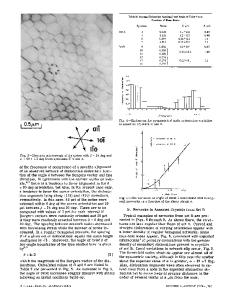Dislocation patterning and conservative recovery in single slip
- PDF / 2,111,414 Bytes
- 6 Pages / 595 x 842 pts (A4) Page_size
- 71 Downloads / 325 Views
Dislocation patterning and conservative recovery in single slip Patrick Veyssière and Fabienne Grégori1 LEM, CNRS-ONERA, BP 72, 92322 Châtillon cedex, France. 1 LPMTM, Institut Galilée, 99 av. J.B. Clément, 93430 Villetaneuse, France. ABSTRACT Prismatic loops generated by cross-slip are organised in staircase-like strings such that the beginning of a loop corresponds in the screw orientation with the end of its neighbour. Strings constitute nucleation sites for dislocation tangles thus offering an explanation for spontaneous patterning in single glide. A loop string can be partially and even totally eliminated by a single impacting dislocation. In dense walls, loop refinement can also take place conservatively by mutual annihilation of loops of opposite signs. INTRODUCTION One of the unexpected results of the early transmission electron microscope (TEM) investigations of deformation microstructures is the widespread occurrence or irregular dislocation tangles and interspersed prismatic loops [1], felt particularly disconcerting in samples strained in single slip. It was nevertheless readily determined that dislocation aggregates consist mainly of dipolar configurations including elongated prismatic loops and, save for some definitive analyses [1], the paramount role of cross-slip in generating such debris became rapidly acknowledged. The question of spontaneous patterning was found even more challenging after several extensive TEM studies revealed the degree of regularity of dislocation walls in fatigued crystals. Despite considerable efforts, the elementary dislocation mechanisms that engender tangles have remained uncertain [2, 3]. There is, however, little doubt that models of microstructural self-organisation should include mechanisms for loop formation and segregation [4, 5]. One concern of this work is some of the mechanisms by which mobile dislocations may achieve this. Another concern is the question of the elimination of prismatic loops that is usually invoked in order to account for the saturation of the dislocation density in walls. EXPERIMENTAL BASIS The present paper takes its origin in the observation of arrays of prismatic loops in γTiAl deformed in single slip by dislocations with Burgers vector 1/2
Data Loading...










